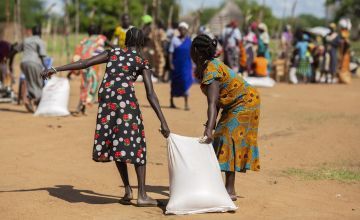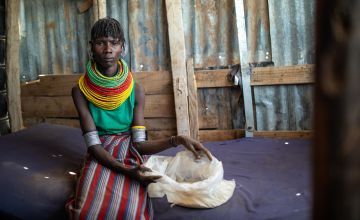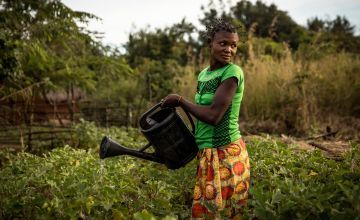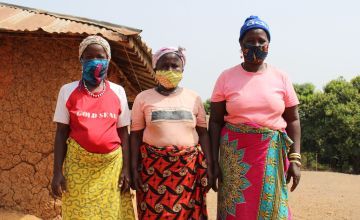
Knowledge Hub
May 28 marks World Hunger Day; a day that aims to raise awareness of the dramatic rise in hunger in recent years. A number of factors are causing this increase in global hunger. But the effect? The lives of millions of women and girls are seriously jeopardized.
Despite decades of progress towards decreased levels of hunger worldwide, the current climate crisis, the impact of Covid-19, and conflicts around the world has driven hundreds of millions of people into food insecurity and poverty. The recent Global Report of Food Crises reveals that in 2021, 193 million people in 53 countries faced acute food insecurity, meaning they were unable to eat enough adequate food, putting their lives and livelihoods in peril. This is an increase of 40 million in 2020.
That this year’s Global Report on Food Crises shows hunger levels in the world still remain alarmingly high is not surprising, but it is a warning for the global community to act urgently to tackle hunger and its root causes – conflict and climate change.
Strengthening gender equality is one of the most fundamental accelerators of sustainable development. Empowering women is a key driver for ending hunger. However, it works the other way around too. Until we make global hunger a thing of the past, women will remain worse off and inequalities will persist.
Women bear the brunt of hunger

Globally, women are much more likely to live in extreme poverty than men. More than 20% of working-age women live in extreme poverty compared to 14% of men, the reasons for which are complex and interconnected. Where there is extreme poverty, there is hunger. Of which women bear the brunt:
-
In nearly two-thirds of countries, women are more likely than men to report food insecurity.
-
Of the 811 million people who are food insecure in the world right now, nearly 60 per cent are women and girls
But why is this?
-
Women often eat last and least in countries facing conflict, famine and hunger. Conflict remains the biggest driver of hunger worldwide, pushing 139 million people in 24 countries into acute food insecurity in 2021; and it hits women the hardest. Many women become the heads of their households when men are away fighting, and they often have very little to give their children. In Ukraine, most of those that fled the country were women and children because the men had to stay at home to fight.
-
When a crisis hits, women are usually the first to sacrifice their own food to ensure their families have enough.
-
Women also suffer the most from nutrient deficiencies, especially during reproductive years, negatively affecting development that is then passed down through generations.
-
Furthermore, in many countries, women have fewer rights than men and less power. For example, although women make up more than half of the world’s agricultural workers, often they are not allowed to own the land they work on or make financial decisions. This affects their purchasing power and ability to direct their livelihoods towards improved nutrition.
Current global food crises putting women’s lives at risk

The Ukraine conflict will have serious repercussions for the world as a whole, but will be potentially devastating for the ongoing fragile and precarious hunger situation in many countries in the Horn of Africa , the Middle-East, and Afghanistan.
Global food chains have been broken. Ukraine and the Russian Federation provide around 30% of the world’s wheat and barley. Thirty-six countries import more than 50% of their wheat from Russia and Ukraine, including Pakistan, Somalia, Lebanon, Turkey, Democratic Republic of Congo, Rwanda, Sudan and Burundi – all countries that Concern works in. The conflict in Ukraine also means that there have been spikes in commodity prices and disrupted supply chains. This results in a lack of resources for poorer countries depending on wheat from the region, for example, and anything available is rocketing in price.
This situation would be difficult in any circumstances, but rising food prices are coming after a series of challenges that have already increased prices, reduced income and exacerbated instability.
In the Horn of Africa, desperately needed rains failed for the fourth consecutive time almost two months into the current rainy season. This could potentially lead to the worst drought in 40 years in a region that is officially facing a near-hunger crisis, as the UN and other humanitarian agencies have unanimously warned. The predictions are alarming: If these conditions continue, a further 20 million people will go hungry this year.
The road to rethinking (because it’s too soon for recovery)
With this in mind, as these crises unfold, without intervention women and girls will be increasingly more at risk from the effects of global hunger. To prevent this, we need to think with an integrated and intersectional mindset when problem solving.
At Concern, a huge part of our work is improving food insecurity through a number of innovative practices.
Community Management of Acute Malnutrition (CMAM )

Our pioneering Community Management of Acute Malnutrition (CMAM) approach funds clinics that provide essential maternal and childhood healthcare for severely malnourished babies and young children, giving children weekly medical treatment and therapeutic food. At the heart of this approach are volunteers in the community who actively screen children and pregnant and breastfeeding women for malnutrition.
Innovative health and nutrition centres in hardest to reach places

Our goal of ending extreme poverty can only be achieved by tackling poverty’s root causes – and high among them are poor public health and nutritional deficiencies.
Last year, Concern built a new life-saving health clinic using old shipping containers in just three months in one of the hottest and poorest parts of the world; Chad. Seeing the desperate medical needs of families living in one particular area, with children suffering from malnutrition and many people falling ill – along with the threat posed by Covid-19 – Concern’s staff in Chad acted fast.
Using old cargo shipping containers, Concern Chad created a permanent health clinic to cater for over 30,000 people. It opened in September 2021 and provides free primary care, including a maternity unit, treatment for malnutrition, vaccinations and a pharmacy.
Livelihoods

Another approach is through our range of livelihood programmes, giving people opportunities to sell food at market, earn a living or grow their own food, with the aim of increasing the quantity and variety of food they have access to.
Looking at women who earn a livelihood through agriculture, well, women farmers make up close to 50% of the agricultural workforce in many of the countries where Concern works. But they lack equal access to the same tools and resources that men have – these include resources such as credit, land, water, organic inputs and raw materials. This means that women farmers are particularly at risk of hunger, especially when crisis strikes.
That’s why we also strive to specifically empower female farmers. Take these three women.

They told us that before Concern’s livelihoods programmes were introduced in their village, women were unable to access land. “If we were married we had to be granted permission by our husbands in order to farm,” Isatu [right] told us. “Thanks to Concern [...] I became the first woman to buy a piece of land on my own! My husband supports me. He doesn’t have the zeal to farm at the same level as me.
Empowering women and girls to fight global hunger
Women and girls prepare most of the world’s meals and grow much of its food, and empowering them to receive the same opportunities and boys and men will bring us closer to ending global hunger.
As such, although women bear the brunt of global hunger, once empowered, they also have the potential to end it.
Concern now designs our programmes around an understanding of extreme poverty in which gender inequality is addressed so our work makes a lasting difference. From providing access to clean water, to developing sustainable livelihoods, or ensuring displaced children have access to education, gender is at the core.
Women of change
Together we can build bridges, remove barriers, bring about positive change and make a lasting impact.
Learn more about the unique challenges women face across the globe
Other ways to help
Donate now
Give a one-off, or a monthly, donation today.
Join an event
From mountain trekking to marathon running, join us for one of our many exciting outdoor events!
Buy a gift
With an extensive range of alternative gifts, we have something to suit everybody.
Leave a gift in your will
Leave the world a better place with a life-changing legacy.
Become a corporate supporter
We partner with a range of organisations that share our passion and the results have been fantastic.
Create your own fundraising event
Raise money for Concern by organising your own charity fundraising event.





